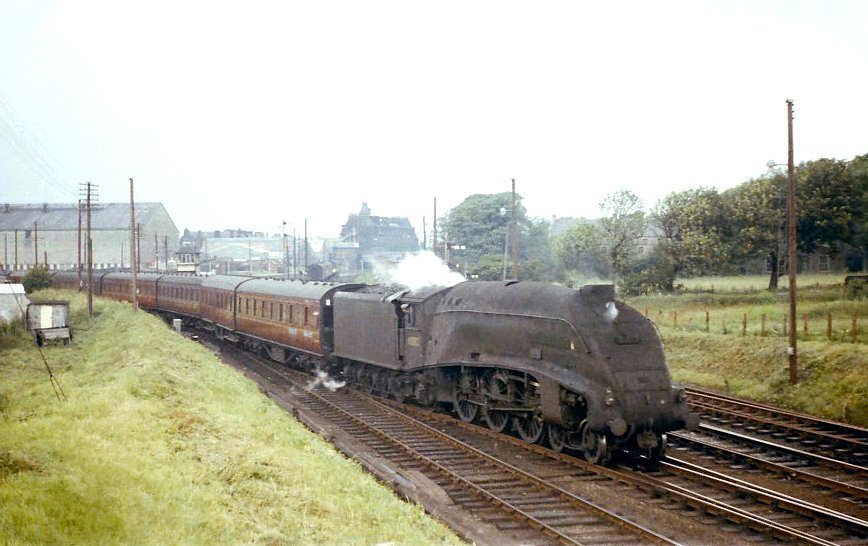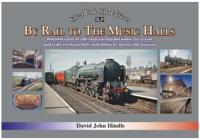By Rail to the Music Halls
David Hindle
Review by Mark BartlettDavid Hindle once again demonstrates his knack of finding new subjects to write about. I am not aware of any other books making a link and bringing together a history of music halls and variety theatres with the railway development that made their growth possible.
As with his previous Cumbrian Coast study (See Railscot Review ) this latest book is a high quality Silver Link Silk Edition with a high percentage of colour images and reproductions of theatre and railway posters, handbills etc. The chapters are laid out like a theatre programme starting with an Overture where David notes that Stephenson’s “Rocket†first ran in 1829 and the first Music Hall opened in 1832, and also that the last steam locomotives and the last music halls came to an end in the 1960s. With his interest in both these subjects David spotted that there was a story to be told plotting the rise and fall of both and this book is the result.
The PROLOGUE chronicles the evolution of music halls and railways, with a particular reference to developments in David’s local town of Preston where the entertainment was poplar with mill workers as a relief from their arduous work lives. David parallels the growth of the music halls with the Victorian development of railways, profusely illustrated with contemporary photographs of both.
The REPRISE is an interesting section on Legislation – with police officers attending all performances to ensure the law and local standards were upheld – and case studies of notable theatres from across the UK. CHAPTER 1 “Footplates & Footlights†looks at the greater mobility of both the public and also the development of travelling artists and whole theatre companies and leads on to the artists and holiday makers travelling by train to Butlin’s holiday camps. CHAPTER 2 looks at two visits by Charles Dickens by train to Preston to give readings in the theatre. The visit to Preston is reputed to have inspired his novel “Hard Times†based on the social conditions he witnessed.
CHAPTER 3 looks at London music halls and notes that by 1865 there were thirty two, varying from 500 to 5000 seats. Fred Matcham, a theatre architect with over eighty Victorian theatres to his credit, is the subject of CHAPTER 4. Many of these are still in use including the Empire in Edinburgh and the Kings in Glasgow. CHAPTER 5 is a case study of the London Coliseum, currently the capital’s largest with 2359 seats.
Linking back to railways CHAPTER 6 is titled the “Bread and Butter Circuit†charting the Broadhead empire of theatres in North West England where artists travelled between the various theatres of the group by train. It was when travelling by train between venues during WWII that the young Morecambe and Wise agreed to form their partnership. CHAPTER 7 charts their incredibly successful career, particularly the twenty five years of touring the music halls, variety theatres and seaside piers. CHAPTER 8 looks at the rise of the cinema and the impact it had in reducing travel by rail as the music halls and their artists declined.
“I do like to be beside the seaside†is the title of CHAPTER 9 covering not just holiday trains but also day excursions, which sometimes included a theatre or pier show ticket.

Ayr: 60002 (52A) shunts its stock from a Saturday Evening Excursion from Glasgow St Enoch to Ayr in the 1960s. Normal motive power would be a Corkerhill 4MT tank. Large building on left is the original Ayr Ice Rink with the station in the middle distance. Bill Hamilton //
There follows a short INTERVAL, comprising eight pages of previously unpublished steam train photographs by Stanley Withers. The connection of these with the Music Hall theme is perhaps a little tenuous but the photographs are excellent.
“All stations to Southport for a night out at The Garrick†is the title of CHAPTER 10, is a study of the Preston to Southport line and its stations and of the Garrick theatre, which closed in 1957, seven years before the railway. Continuing this theme CHAPTER 11 is the self-explanatory “By ship, steam train and horse tram to the Gaiety Theatre, Isle of Manâ€.
CHAPTER 12 is a study of nine surviving British music halls and variety theatres including the Gaiety in Ayr and the Pavilion Theatre of Varieties in Edinburgh. CHAPTER 13 is described as “A pot-pourri of comic railway interludes†and includes anecdotes from David’s favourite railway, the Preston and Longridge, and a look at railway excursions to see public executions! The book concludes with an excellent selection of steam excursion photographs by Peter Fitton.

Morecambe Euston Road: An early, colourised, postcard showing 'Visitors arriving at Morecambe'. Although this was found in the old Midland Railway Promenade station it is actually of the LNWR station at Euston Road, with its curved platform and centre release road. Euston Road finally closed after the 1962 summer season and sheltered accommodation flats have occupied the site for many years See image [[67653]] although the old goods shed and yard are still in use by a builders' merchant. Mark Bartlett Collection //
The 180 plus pages of this excellent and unusual book contain a wealth of information that will be of interest to social historians and those with an interest in railways and/or the world of entertainment in the 19th and 20th centuries. Where will David Hindle take us next?
Available from:
Mortons Books, Mortons Media Group, Media Centre, Morton Way, Horncastle, Lincolnshire, LN9 6JR
Website: Mortons Books
Mortons Books
ISBN: 978 1 85794 541 6

160 pages, with mainly colour.
Mortons Books
or from Amazon Amazon
